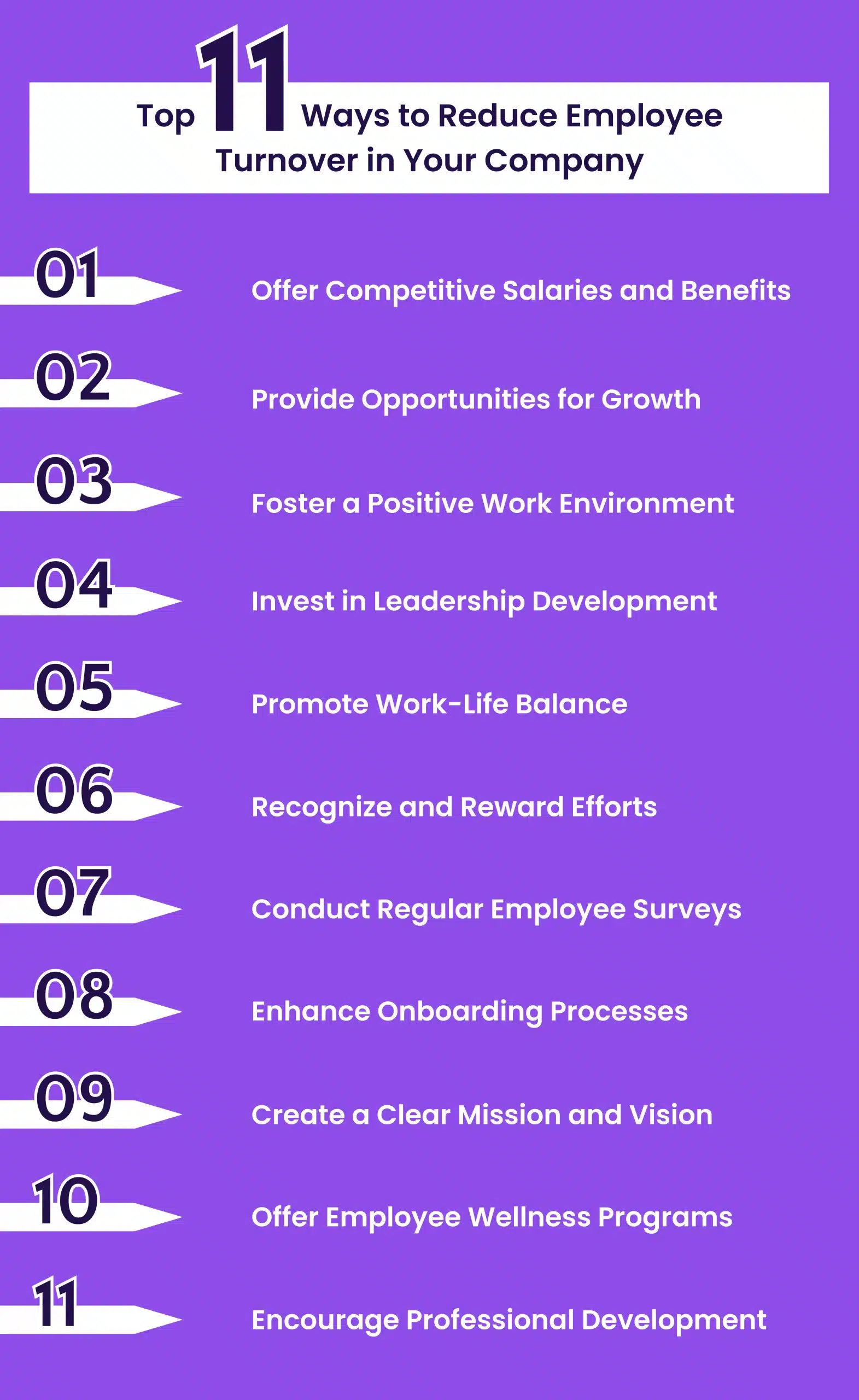Table of content
As a founder, I’ve experienced firsthand the frustration and financial strain of high employee turnover. When talented team members leave, it’s more than just an inconvenience; it’s a hit to your company’s morale, productivity, and bottom line. Every time a valued employee walks out the door, you lose their skills and expertise and the investment you’ve made in their training and development.
High turnover rates can set off a vicious cycle. The remaining employees often bear the brunt, feeling overburdened and less motivated, which can trigger even more resignations. Moreover, the constant need to recruit, hire, and train new employees can deplete your resources and divert your attention from growth and innovation.
Reducing employee turnover is about creating a workplace where people feel valued, engaged, and motivated to contribute their best. From my own journey as a founder, I’ve learned that addressing turnover proactively can transform your business culture and drive success.
In this blog, I’ll share the top 11 ways to reduce employee turnover based on my experiences and insights. These employee retention strategies have helped me build a more stable, satisfied workforce, and I’m confident they can do the same for you. Let’s dive in and explore how you can create a work environment where employees thrive and want to stay for the long haul.
Why Do Employees Leave? Understanding the Root Causes
While running Supersourcing, I’ve spent countless hours trying to understand why employees decide to leave our company. It’s not always about the obvious reasons like salary or benefits—though those certainly play a part. The truth is the reasons can be complex and varied, but understanding them is crucial for any leader committed to reducing turnover.
Lack of Growth Opportunities
One of the most common reasons I’ve encountered is the lack of growth opportunities. Talented employees are ambitious—they want to learn, grow, and advance in their careers. If they feel stuck in a dead-end job with no clear path for progression, they’ll likely start looking for other opportunities. In my early days, I underestimated the importance of career development plans. It wasn’t until we implemented structured paths for advancement and continuous learning that we saw a noticeable drop in turnover.
Poor Management
Another significant factor is management. People don’t leave jobs; they leave managers. I’ve had to learn this the hard way. Early on, I hired managers based solely on their technical skills, overlooking the essential soft skills needed to lead and inspire a team. Ineffective or unsupportive management can create a toxic work environment, leading employees to seek better leadership elsewhere. Investing in leadership training and fostering a culture of supportive management has been pivotal in retaining our talent.
Work-Life Balance
Work-life balance is another critical aspect. In the hustle of building a company, it’s easy to push your team too hard, expecting long hours and constant availability. I’ve made this mistake, believing that high productivity requires relentless effort. But this approach only leads to burnout and resentment. We had to reassess our expectations and create policies that promote a healthier work-life balance. Flexible working hours, remote work options, and encouraging time off have all contributed to happier, more loyal employees.
Company Culture
Cultural fit cannot be overstated. Employees want to feel they belong and that their values align with the company’s. In our early stages, we focused heavily on skills and experience during hiring, often neglecting cultural fit. This led to friction and dissatisfaction among team members. We’ve since shifted to a more holistic hiring process that considers both qualifications and alignment with our core values. This has helped us build a more cohesive, committed team.
Recognition and Appreciation
Recognition and appreciation—or the lack thereof—can drive employees away. I remember losing a key team member because they felt their hard work went unnoticed. It was a wake-up call for me. Regularly acknowledging achievements, both big and small, and creating a culture of appreciation can make a significant difference in employee satisfaction and retention.
Top 11 Ways to Reduce Employee Turnover in Your Company
Reducing employee turnover has been one of the most impactful changes we’ve implemented in our company. After experiencing the turmoil of losing talented team members, we realized the importance of proactive strategies. Here are the top 11 ways to reduce employee turnover that have significantly improved our retention rates.
1. Offer Competitive Salaries and Benefits
One of the most straightforward ways to reduce employee turnover is by offering competitive compensation. Employees need to feel valued, and part of that comes from knowing their skills and efforts are adequately compensated. Regularly review and adjust salaries and benefits to stay competitive in the market.
2. Provide Opportunities for Growth
Creating clear career development plans is essential. We found that offering training programs, mentorship opportunities, and paths for promotion are effective ways to reduce employee turnover. Employees are more likely to stay when they see a future within the company.
3. Foster a Positive Work Environment
A positive work culture is crucial. Encourage open communication, team collaboration, and a supportive atmosphere. This not only boosts morale but also reinforces employees’ commitment to the company. Happy employees are less likely to leave, making this one of the best ways to reduce employee turnover.
4. Invest in Leadership Development
As mentioned earlier, people leave managers, not companies. Investing in leadership development ensures that your managers have the skills to lead effectively and empathetically. Good managers can significantly reduce turnover by creating a supportive and motivating work environment.
5. Promote Work-Life Balance
Implement policies that support work-life balance, such as flexible working hours and remote work options. By acknowledging and accommodating personal needs, you demonstrate that you value your employees’ well-being, which is a key way to reduce employee turnover.
6. Recognize and Reward Efforts
Regular recognition and rewards go a long way in making employees feel appreciated. Implementing a recognition program where employees’ hard work is acknowledged can greatly reduce employee turnover. When people feel valued, they’re more likely to stay.
7. Conduct Regular Employee Surveys
Feedback is vital. Regularly survey your employees to understand their concerns and suggestions. Addressing their feedback shows that you care about their opinions and are committed to making improvements, which helps in reducing turnover.
8. Enhance Onboarding Processes
A strong onboarding process helps new hires integrate smoothly into the company. Provide them with the necessary resources, training, and support from day one. This sets the tone for their entire employment experience and is an effective way to reduce employee turnover from the start.
9. Create a Clear Mission and Vision
Employees want to work for a company with a purpose. Clearly communicate your mission and vision, and show how each employee’s role contributes to it. When employees feel connected to the company’s goals, they’re more likely to stay, making this one of the impactful ways to reduce employee turnover.
10. Offer Employee Wellness Programs
Invest in wellness programs that address physical, mental, and emotional health. Providing resources like fitness memberships, counselling services, and stress management workshops can enhance overall employee satisfaction and loyalty.
11. Encourage Professional Development
Support your employees’ professional growth by providing opportunities for further education, certifications, and attending industry conferences. This not only improves their skills but also shows that you are invested in their long-term success, which is a key way to reduce employee turnover.
Conclusion
Reducing employee turnover is more than just a strategic move—it’s about creating a thriving workplace where people feel valued, supported, and motivated. From my journey as a founder, I’ve learned that the key ways to reduce employee turnover involve a holistic approach that addresses compensation, growth opportunities, work-life balance, and company culture.
Each of these top 11 ways to reduce employee turnover is a piece of the larger puzzle in building a loyal and productive workforce. When employees feel appreciated and see a clear path for their future within the company, they’re more likely to stay and contribute to the organization’s success.
Moreover, if you’re looking to hire top tech talent for your organization, Supersourcing can help! We have built an extensive pool of highly experienced candidates who are ready to bring their expertise to your team. Don’t let the challenges of finding and retaining great employees hold your company back. Contact us today to learn more about how Supersourcing can provide you with the exceptional tech talent you need to drive your business forward.


